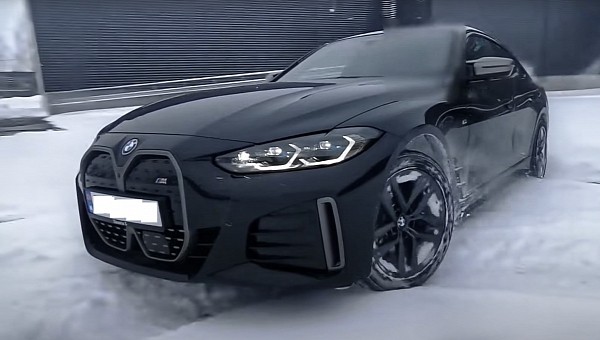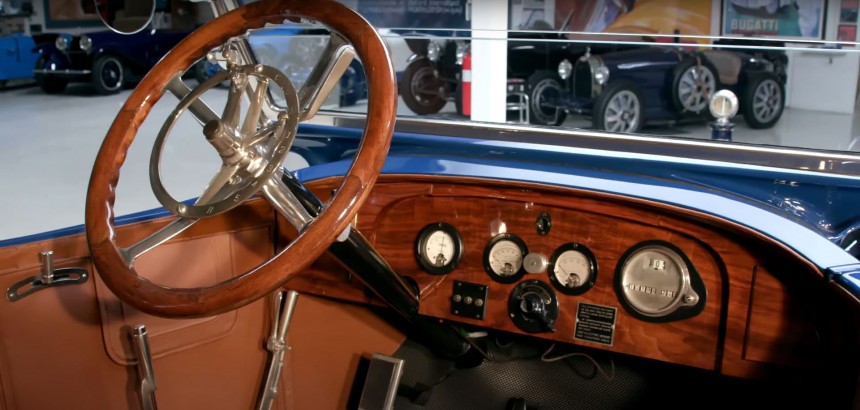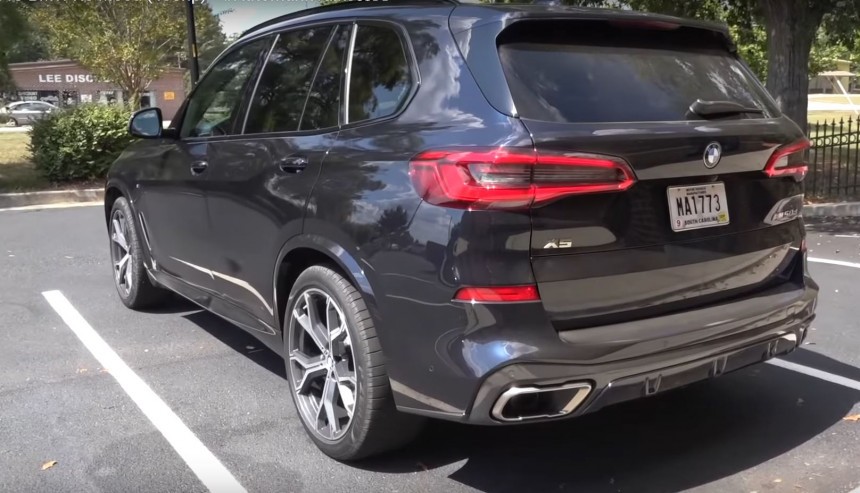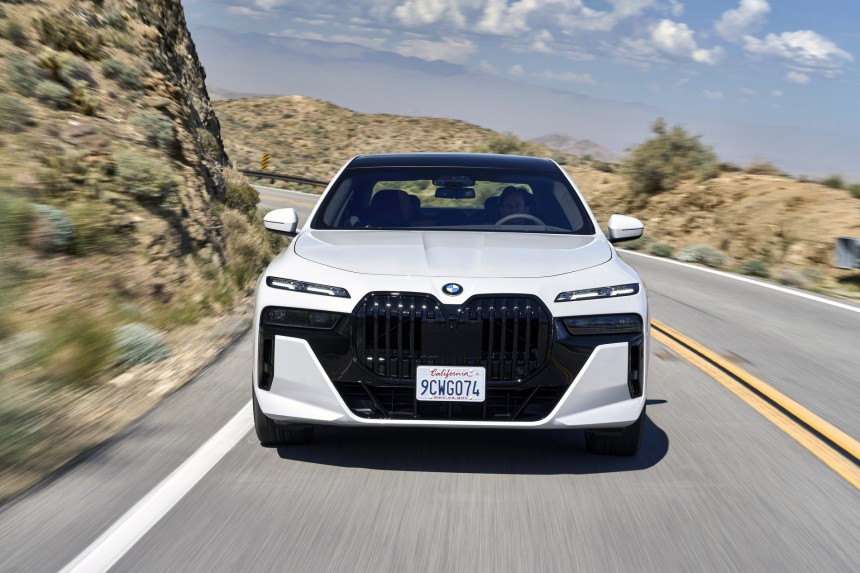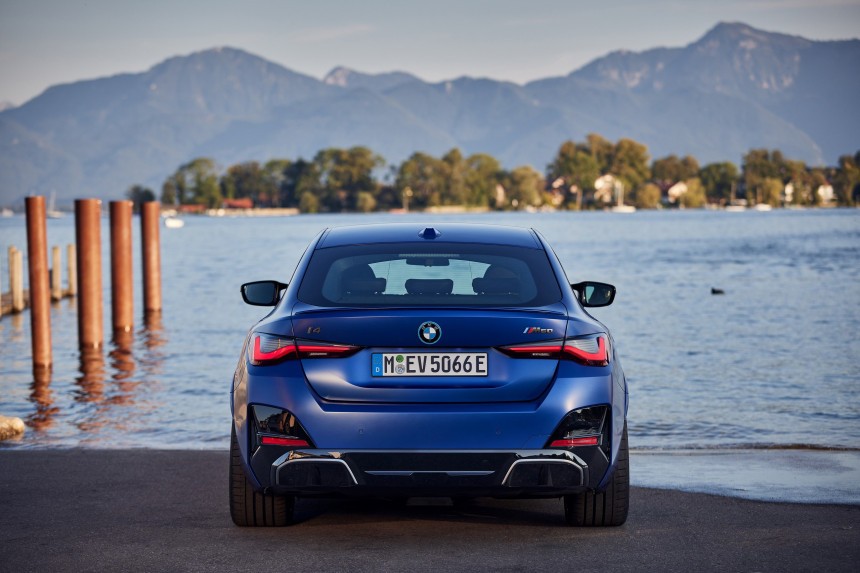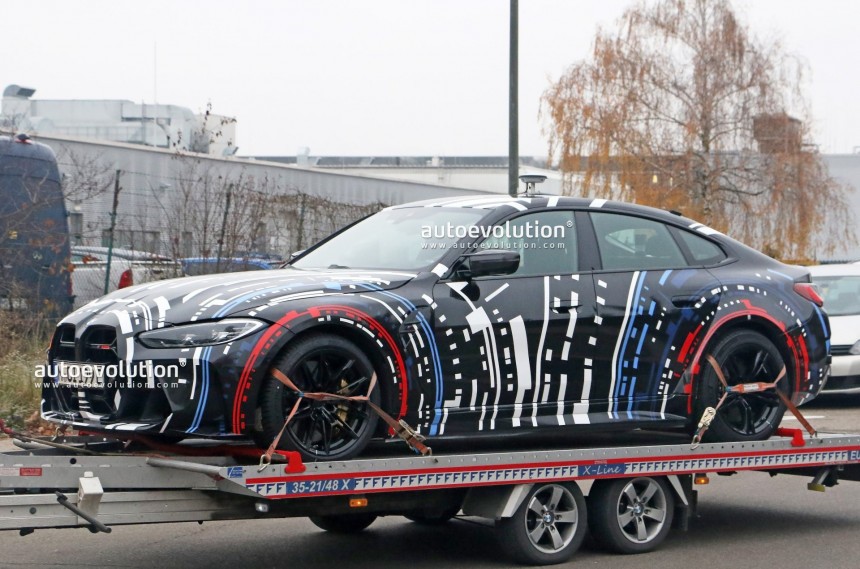Today, EVs are (somewhat forcibly) associated with self-driving technologies and other gimmicks. But the high-performance division of BMW is trying to remain true to its roots. And that’s great news for fans and prospective customers.
Cars powered by the wonders brought to us by electricity are not a contemporary discovery. Yes, the past decade has given us all something to think about when it comes to personal mobility. But the first EVs appeared well over 100 years ago. Take the rear-wheel-drive Owen Magnetic as an example. Although it was a hybrid, the manufacturer managed to use the gas engine as efficiently as possible. To put it simply, it was a gas-powered electric vehicle. Imagine a Chevrolet Volt but without the plug-in part.
You may wonder why in a story about BMW M’s zero-tailpipe emission future, there’s talk about a very rare vehicle that isn’t even that well-known. Well, we’re doing it for a good reason. Back in the 1900s, battery technology wasn’t as good as it is today. Even now, car and technology companies are scrambling to find new ways to store energy for electric vehicles. Over a century ago, the challenges were similar, albeit a tad bit more complicated.
But Owen knew they had to compromise. So, for driving comfort’s sake, the brand decided to do some out-of-the-box thinking – have a six-cylinder gas engine power an electric generator that, in turn, runs “the car of a thousand speeds.” Of course, this became very expensive in the end. The solution did not appeal to many customers.
However, it proved that you could enhance a vehicle’s ride quality without focusing too much on the cabin or the suspension. The car delivered power way smoother than a non-hybrid counterpart, eliminated the heavy clutch, and there was no need to change gears manually.
But enough of that. What’s in the past, it’s in the past. And that’s what BMW might be thinking as well.
But times, well, they are a-changin’. For now, the manufacturer continues to have a very well-rounded portfolio of vehicles and powertrains in some markets, but things won’t remain the same for much longer. As governments around the world decide that fossil fuel-powered cars need to be gradually phased out, auto companies must adapt and, of course, try to innovate. A brand like BMW can’t continue to offer a plethora of choices to customers forever.
Not because it doesn’t want to, no. It’s thanks to having major competition in the space and a good name to maintain. So, selling things like the BMW iX3 – which does not offer what an EV built from the ground up should – isn’t going to be feasible long term. The competition is just too tight in this space.
While this is a thing known and accepted by the Bavarian entity, the transition to a zero-tailpipe emission future is even more complicated for the high-performance arm of the luxury car company.
Bearing in its name “the most powerful letter in the world,” BMW M must keep the thrill offered by its vehicles and make sure they aren’t polluting locally. While it may seem simple to adopt a solution like Lucid’s tri-motor Air Sapphire or Rivian’s quad-motor R1S (don’t forget the X5 M or the X5 M50d), BMW can’t just copy what newcomers are doing.
But before jumping into the “Neue Klasse” shenanigans, let’s take a break and look at something BMW made that also had the “quad” term in it – a three-liter diesel engine with enough power to make you think that you’re burning gas and, who knows, maybe even rubber!
Equipped on a couple of models like the very popular X5 SAV (Sports Activity Vehicle, according to BMW lingo) or even the top dog 7 Series when bought in its 750d version, this expensive-to-build and to-maintain engine (known by aficionados as the B57S) didn’t have a very long life. Asides from being costly, it slowly turned into something of a forbidden fruit in markets where it was sold due to the unpopularity of diesel-powered engines. But BMW knows not to give up, even when it retires something as cool as this power unit.
So, a quad-motor solution instead of slapping four turbos on a diesel-powered engine and some clever tech might just do it.
Even though it sounds great, there isn’t a large network of high-power chargers that can support this performance. Plus, protecting the 101.7-kWh battery from degrading too fast is also something the Bavarians might have had in mind when they decided to go with the 400V option. Charging at high speeds often might not be such a good idea. Plus, most EV buyers have Level 2 chargers at home, which have a power output between 7 to 19 kW.
But the very existence of the dual-motor i7 encourages us to think that an M version will most likely enhance all these capabilities, but it’s doubtful that BMW will change its platform to support the 800V architecture – for now.
At this point, we can give up on guessing what BMW M will do soon because – believe it or not – the i4 M50 is now the company’s best-selling vehicle. I highly disagreed with the go-faster arm of the Bavarian automaker when the all-electric 4 Series Gran Coupe was introduced in its best version as “the first fully-electric M car.” I expected only the best from BMW M and a 544-hp (552-ps) four-door sedan wasn’t it. The very existence of something like the 1,020-hp (1,035-ps) Tesla Model S Plaid made me think that the Germans weren’t quite ready to tackle the EV situation seriously.
However, the i4 M50 sales results prove BMW’s customers (and others watching from the sidelines) are ready to make the switch. This confirms that, aside from the charging on long journeys and the lack of engine noise, people are seriously starting to warm up to battery-electric vehicles and the lifestyle change associated with them.
But looking at what American competitors are doing… Well, let’s just say the i4 M50 and even the iX M60 aren’t equipped to handle what Tesla, Rivian, or Lucid are currently doing.
The company’s plans for the near future revolve around a brand-new platform for battery-electric vehicles (BEVs) called Neue Klasse (New Class). If you’re one of our frequent readers or a knowledgeable Bimmer fan, then you already know what this is about.
Essentially, the Bavarian automaker will debut a completely new architecture for BEVs. This includes the chassis, the battery, and the motors. But, as proven at CES 2023, Neue Klasse might end up including a lot more. The i Vision Dee concept promised us a design language and a couple of nifty innovations that may or may not make it onto the production vehicle.
However, aside from the color-changing paint job and windows that can show avatars to others (something that will surely get exploited by entities who want to find new ways to advertise), BMW M spilled out an important secret – its quad-motor EV monster won’t be just a straight line accelerating monster. No, the Bavarians are also playing with a new Electronic Control Unit (ECU). This small device, according to what BMW M CEO Frank van Meel told Autocar, is going to control everything. But it won't be just another computer, no. It will make sure the differentials and the other dynamic driving systems work as best as they can to provide exactly what the driver wants – maximum traction or a playful setup. While doing this, it will also assess what exactly the car can do before it puts too much strain on itself.
Named the “Hand of God” because it can transform how the car feels at the push of a button (or a tap on the screen, who knows), this ECU is inspired by nonother than the one found on the controversial i8. The spaceship-looking plug-in hybrid (PHEV) didn’t find much love among BMW M fans because, well, it was an expensive BMW i vehicle, and not many people wanted to boast about having a three-cylinder 1.5-liter MINI engine under the hood. However, back in 2016, it earned the title of the world’s highest-selling hybrid sports car, and it also won the Engine of the Year Award.
But the ECU continued to live on, even if the i8's production stopped. The M cars it was installed on, especially the M5 F90, were hailed as one of the best in their class. The executive thinks the updated ECU will work perfectly with the upcoming quad-motor all-electric M vehicle. Powering the front axle means it can also take advantage of regenerative braking, while the versatility of the computer allows for an even greater degree of customization.
At the same time, I sure hope that the “Hand of God” isn’t just Hans Zimmer’s music. BMW M has the potential to create an EV that keeps drivers passionate about their vehicles, even if the engine noise won’t be there anymore and changing gears won’t matter.
BMW, if you’re reading this – do not, and I repeat, do not (even for a minute) – think about giving up on driving dynamics in the EV era. Give the world a zero-tailpipe emission car portfolio that will somehow keep the gearheads entertained. Don’t destroy the “Ultimate Driving Machine” moniker.
Finally, as exciting or as controversial as it may be, the future of personal mobility is being built around the zero-tailpipe emission concept. For now, the development phase of these “clean vehicles” may seem similar to that of the Ford Model T, but it is slowly yet surely turning mainstream. However, there are a lot of bumps in the road ahead, and we’ll have to deal with them all. Until we figure out something that can work for everybody, everywhere… Let’s keep on keeping on.
You may wonder why in a story about BMW M’s zero-tailpipe emission future, there’s talk about a very rare vehicle that isn’t even that well-known. Well, we’re doing it for a good reason. Back in the 1900s, battery technology wasn’t as good as it is today. Even now, car and technology companies are scrambling to find new ways to store energy for electric vehicles. Over a century ago, the challenges were similar, albeit a tad bit more complicated.
But Owen knew they had to compromise. So, for driving comfort’s sake, the brand decided to do some out-of-the-box thinking – have a six-cylinder gas engine power an electric generator that, in turn, runs “the car of a thousand speeds.” Of course, this became very expensive in the end. The solution did not appeal to many customers.
But enough of that. What’s in the past, it’s in the past. And that’s what BMW might be thinking as well.
Bring Me a Win
In some parts of the world, BMW has been on quite a mission. For example, people living in the UK have no less than four powertrains to choose from when it comes to getting a new X3. The popular crossover can come with a gas- or diesel-powered engine, a plug-in hybrid solution, or even completely electric. Known as “the power of choice” strategy, this allowed BMW buyers to get exactly what they wanted.But times, well, they are a-changin’. For now, the manufacturer continues to have a very well-rounded portfolio of vehicles and powertrains in some markets, but things won’t remain the same for much longer. As governments around the world decide that fossil fuel-powered cars need to be gradually phased out, auto companies must adapt and, of course, try to innovate. A brand like BMW can’t continue to offer a plethora of choices to customers forever.
Not because it doesn’t want to, no. It’s thanks to having major competition in the space and a good name to maintain. So, selling things like the BMW iX3 – which does not offer what an EV built from the ground up should – isn’t going to be feasible long term. The competition is just too tight in this space.
While this is a thing known and accepted by the Bavarian entity, the transition to a zero-tailpipe emission future is even more complicated for the high-performance arm of the luxury car company.
But before jumping into the “Neue Klasse” shenanigans, let’s take a break and look at something BMW made that also had the “quad” term in it – a three-liter diesel engine with enough power to make you think that you’re burning gas and, who knows, maybe even rubber!
Equipped on a couple of models like the very popular X5 SAV (Sports Activity Vehicle, according to BMW lingo) or even the top dog 7 Series when bought in its 750d version, this expensive-to-build and to-maintain engine (known by aficionados as the B57S) didn’t have a very long life. Asides from being costly, it slowly turned into something of a forbidden fruit in markets where it was sold due to the unpopularity of diesel-powered engines. But BMW knows not to give up, even when it retires something as cool as this power unit.
So, a quad-motor solution instead of slapping four turbos on a diesel-powered engine and some clever tech might just do it.
But first, a couple of tryouts
BMW’s latest EV – the i7 xDrive 60 – is not an M car. However, it impresses with its driving dynamics and ride quality. Even though it weighs 5,917 lb (2,684 kg), the luxurious sedan can eat up mountain roads. Unfortunately, it doesn’t have the 800V charging architecture. This upgrade found on BEVs sold by brands like Hyundai, Porsche, or Kia theoretically allows cars to extract energy at a rate of around 360 kW per hour.But the very existence of the dual-motor i7 encourages us to think that an M version will most likely enhance all these capabilities, but it’s doubtful that BMW will change its platform to support the 800V architecture – for now.
At this point, we can give up on guessing what BMW M will do soon because – believe it or not – the i4 M50 is now the company’s best-selling vehicle. I highly disagreed with the go-faster arm of the Bavarian automaker when the all-electric 4 Series Gran Coupe was introduced in its best version as “the first fully-electric M car.” I expected only the best from BMW M and a 544-hp (552-ps) four-door sedan wasn’t it. The very existence of something like the 1,020-hp (1,035-ps) Tesla Model S Plaid made me think that the Germans weren’t quite ready to tackle the EV situation seriously.
However, the i4 M50 sales results prove BMW’s customers (and others watching from the sidelines) are ready to make the switch. This confirms that, aside from the charging on long journeys and the lack of engine noise, people are seriously starting to warm up to battery-electric vehicles and the lifestyle change associated with them.
But looking at what American competitors are doing… Well, let’s just say the i4 M50 and even the iX M60 aren’t equipped to handle what Tesla, Rivian, or Lucid are currently doing.
This too shall change – for the better
For the sake of not being plain wrong, let me just say that BMW might have looked at what American automakers are doing and learned a thing or two. That’s why it’s preparing something completely new which will debut on an M model.Essentially, the Bavarian automaker will debut a completely new architecture for BEVs. This includes the chassis, the battery, and the motors. But, as proven at CES 2023, Neue Klasse might end up including a lot more. The i Vision Dee concept promised us a design language and a couple of nifty innovations that may or may not make it onto the production vehicle.
However, aside from the color-changing paint job and windows that can show avatars to others (something that will surely get exploited by entities who want to find new ways to advertise), BMW M spilled out an important secret – its quad-motor EV monster won’t be just a straight line accelerating monster. No, the Bavarians are also playing with a new Electronic Control Unit (ECU). This small device, according to what BMW M CEO Frank van Meel told Autocar, is going to control everything. But it won't be just another computer, no. It will make sure the differentials and the other dynamic driving systems work as best as they can to provide exactly what the driver wants – maximum traction or a playful setup. While doing this, it will also assess what exactly the car can do before it puts too much strain on itself.
Named the “Hand of God” because it can transform how the car feels at the push of a button (or a tap on the screen, who knows), this ECU is inspired by nonother than the one found on the controversial i8. The spaceship-looking plug-in hybrid (PHEV) didn’t find much love among BMW M fans because, well, it was an expensive BMW i vehicle, and not many people wanted to boast about having a three-cylinder 1.5-liter MINI engine under the hood. However, back in 2016, it earned the title of the world’s highest-selling hybrid sports car, and it also won the Engine of the Year Award.
Let’s wrap it up
This talk about the “Hand of God” might seem just like something a marketing person would do to keep prospective customers interested in a future product. Now... A motor for each wheel, a skateboard platform that houses a heavy battery, and a vehicle crammed with all sorts of computers and sensors don’t sound like things that, once put together, would create something great to experience on the track or the Autobahn. But BMW M knows it must at least maintain the same degree of fascination for its EVs as it happens with the internal combustion engine units.At the same time, I sure hope that the “Hand of God” isn’t just Hans Zimmer’s music. BMW M has the potential to create an EV that keeps drivers passionate about their vehicles, even if the engine noise won’t be there anymore and changing gears won’t matter.
BMW, if you’re reading this – do not, and I repeat, do not (even for a minute) – think about giving up on driving dynamics in the EV era. Give the world a zero-tailpipe emission car portfolio that will somehow keep the gearheads entertained. Don’t destroy the “Ultimate Driving Machine” moniker.
Finally, as exciting or as controversial as it may be, the future of personal mobility is being built around the zero-tailpipe emission concept. For now, the development phase of these “clean vehicles” may seem similar to that of the Ford Model T, but it is slowly yet surely turning mainstream. However, there are a lot of bumps in the road ahead, and we’ll have to deal with them all. Until we figure out something that can work for everybody, everywhere… Let’s keep on keeping on.
